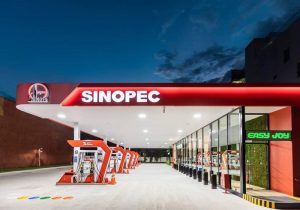Chinese petroleum giant Sinopec signed an agreement with Sri Lanka on Monday to enter the South Asian island country’s retail fuel market as it struggles to resolve a worsening energy crisis amid an unprecedented economic upheaval.
The contract agreement would enable Sinopec to import, store, distribute, and sell petroleum products in Sri Lanka, which has had a fuel shortage for more than a year.
The move comes as Beijing looks to consolidate investments in Sri Lanka’s ports and energy sector amid growing security concerns raised by the island nation’s immediate neighbor, India, which considers Sri Lanka to be its strategic backyard.
Sri Lanka, which is facing a foreign exchange crisis, hopes the deal will help to resolve its energy crisis.
The agreement signed Monday in the Sri Lankan capital, Colombo, was made to “ensure uninterrupted fuel supplies to consumers,” the president’s office said in a news release.
Under the pact, Sinopec will be granted a 20-year license to operate 150 fuel stations currently operated by Sri Lanka’s state-run Ceylon Petroleum Corporation, and to invest in 50 new fuel stations and in the country’s energy sector, the nation’s Power and Energy Ministry said in a statement. Sinopec can start operations within 45 days of license issuance.
“This development brings hope for a more stable and reliable fuel supply, boosting the country’s energy sector and providing assurance to consumers,” the president’s office said.
When the economic crisis hit Sri Lanka last year, the government couldn’t find foreign currency to import fuel, triggering a severe shortage that lasted for more than two months and forcing people to endure long lines at fuel stations. Sri Lankans are still allotted limited amounts of fuel that is distributed according to a QR code system.
In an effort to resolve the crisis, Sri Lanka opened its retail fuel market to foreign petroleum companies, asking them to use their own funds to purchase fuel, without depending on Sri Lankan banks for foreign exchange. The government has given approval to two other foreign companies — Australia’s United Petroleum and U.S. company RM Parks in collaboration with Shell — to enter its fuel market.
An Indian oil company already operates in Sri Lanka. But India is concerned over the growing influence of China in Sri Lanka, which sits along one of the world’s busiest shipping routes.
Sri Lanka borrowed heavily from China over the past decade for infrastructure projects including a seaport, airport, and a city being built on reclaimed land. The projects failed to earn enough revenue to pay for the loans, a factor in Sri Lanka’s economic woes. In 2017, Sri Lanka leased the seaport in Hambantota to China to get a quick infusion of cash to make debt payments.
China accounts for about 20 percent of Sri Lanka’s loans.
Sri Lanka’s economic crisis resulted in severe shortages of essentials such as medicines, fuel, cooking gas, and food, leading to angry protests that forced then-President Gotabaya Rajapaksa to flee Sri Lanka and resign last summer.
Sri Lanka defaulted on payment of foreign debts and sought the support of international partners and organizations to resolve the crisis.
The IMF approved a nearly $3 billion rescue program for in March, which will run for four years. Sri Lanka authorities are now discussing debt restructuring with foreign creditors.

































